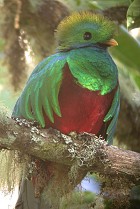- Quetzal
Taxobox
name = Quetzals

image_width = 140px
image_caption = Resplendent Quetzal
regnum =Animal ia
phylum = Chordata
classis = Aves
ordo =Trogoniformes
familia =Trogonidae
genus = "Pharomachrus"
de la Llave. 1832
"Euptilotis"
Gould, 1858
subdivision_ranks = Species
subdivision = "P. antisianus"
"P. auriceps"
"P. fulgidus"
"P. mocinno"
"P. pavoninus"
"E. neoxenus"Quetzals are strikingly colored
bird s of thetrogon family (Trogonidae ) found in tropical regions of theAmericas .The word "quetzal" was originally used for just the
Resplendent Quetzal , "Pharomachrus mocinno", the famous long-tailed quetzal ofCentral America , which is the national bird ofGuatemala . It still often refers to that bird specifically but now also names all the species of the genera "Pharomachrus" and "Euptilotis". The six quetzal species and their English common names are:
* "P. antisianus":Crested Quetzal
* "P. auriceps":Golden-headed Quetzal
* "P. fulgidus":White-tipped Quetzal
* "P. mocinno":Resplendent Quetzal
* "P. pavoninus":Pavonine Quetzal
* "E. neoxenus":Eared Quetzal "Euptilotis neoxenus" is related to "Pharomachrus" and is called the Eared Quetzal by some authorities, such as the
American Ornithologists' Union , but the Eared Trogon by others.Etymology
The name "quetzal" is from
Nahuatl "quetzalli", "large brilliant tail feather" ("American Heritage Dictionary") or "tail coverts of the quetzal" ("Merriam-Webster Collegiate Dictionary"), from the Nahuatl root "quetz" = "stand up" used to refer to an upstanding plume of feathers."Pharomachrus" is from ancient Greek "pharos", "mantle", and "makros", "long", referring to the wing and tail coverts of the Resplendent Quetzal. (The second "h" is unexplained.)
ee also
*
Quetzalcoatl
*List of English words of Nahuatl origin
*List of Spanish words of Nahuatl origin External links
*ITIS|ID=553589
* [http://www.mangoverde.com/birdsound/index.html Mangoverde.com] For images of four quetzal species, select "Trogons".
* [http://ibc.hbw.com/ibc/phtml/familia.phtml?idFamilia=87 Trogon videos] , including quetzals, on the Internet Bird Collection
Wikimedia Foundation. 2010.
